移动城域网项目
Juniper MX 宽带接入服务器配置模板
瞻博网络信息咨询(上海)有限公司
�
目 录
第一部分, MX960 设备开局配置指导................................................................................................................................3
1. 系统基本配置...................................................................................................................................................................3
设置设备的主机名字(主机名见集成商规化),增加管理带外管理的interface ......................................................3
增加管理者帐号...................................................................................................................................................................4
增加操作者帐号...................................................................................................................................................................4
打开telnet 功能,进行连接数以及空闲时间设置...........................................................................................................4
配置telnet 源地址限制,只允许特定的IP 段telnet 设备...............................................................................................4
配置syslog ,并在本地保存所有log 日志........................................................................................................................5
配置SNMP ...........................................................................................................................................................................5
设置本机时间及NTP 和时区设置(NTP Server 需从集成商或市公司取得)............................................................6
2. 全局和调用参数配置 ...................................................................................................................................................... 6
设置动态的profile 配置,根据业务vlan 需求可配置为单层vlan 或者双层vlan........................................................6
配置pppoe 业务用户上线记录log 功能............................................................................................................................ 7
Qos 全局配置限速策略........................................................................................................................................................7
3. 上行端口和防病毒 ACL 配置........................................................................................................................................ 9
配置防病毒ACL .................................................................................................................................................................. 9
配置loopback 接口............................................................................................................................................................ 11
配置上行接口.....................................................................................................................................................................11
4. 路由协议配置.................................................................................................................................................................11
负载均衡配置.....................................................................................................................................................................11
OSPF 路由配置..................................................................................................................................................................12
ISIS 路由配置.....................................................................................................................................................................13
BGP 配置(详见集成商方案)........................................................................................................................................13
LDP/MPLS 配置.................................................................................................................................................................14
第二部分, MX960 业务配置指导 ......................................................................................................................................14
PPPOE 拔号业务配置................................................................................................................................................... 15
配置ip 地址池....................................................................................................................................................................15
配置Radius 服务器............................................................................................................................................................15
配置业务侧端口.................................................................................................................................................................15
2. 专线业务配置.................................................................................................................................................................16
配置静态用户的网关接口.................................................................................................................................................16
配置用户及相关属性.........................................................................................................................................................17
配置用户应用属性.............................................................................................................................................................17
1.
�
修改人修改人//时间时间
张锦章张锦章/20/20120305
120305
18910598815
18910598815
randyzh@juniper.net
randyzh@juniper.net
版本号版本号
V1.0V1.0
V1.1V1.1
V1.2V1.2
主要更新内容
主要更新内容
文档初稿编写
文档初稿编写
本文描述 Juniper MX960 在移动城域网项目中的开局和业务的配置指导。
第一部分,
MX960 设备开局配置指导
1. 系统基本配置
设置设备的主机名字 (主机名见集成商规化),增加管理带外管理的 interface
groups {
re0 {
# Routing Engine 0 在MX960上
host-name JSTZ-MC-CMNET-BRAS-ZHL-MX960.RE0; #在主引擎上配置主机名
# Routing Engine 1 在MX960上
host-name JSTZ-MC-CMNET-BRAS-ZHL-MX960.RE1;
unit 0 {
family inet {
no-redirects;
address 192.168.0.202/24;
apply-groups [ re0 re1 ]; #全局应用
#增加带外管理端口
link-mode full-duplex;
unit 0 {
family inet {
no-redirects;
address 192.168.0.201/24;
system {
}
interfaces {
fxp0 {
}
}
}
}
}
re1 {
system {
}
interfaces {
fxp0 {
}
}
}
}
}
}
�
注:管理口具有路由功能,也会被发布到 local 的路由域里面,在应用到路由协议中时注意
disable 管理端口,避免发布到路由域里面。
增加管理者帐号
#增加用户名为admin的管理用户
#用户识别id,设备上具有唯一性
encrypted-password "aHsrk6sbWc1"; ## SECRET-DATA #此 为show 命 令时 显 示 配置 , 实 际配 置 用
user operator{
#增加用户名为operator的操作者用户,不能进行配置更改
encrypted-password "$1$RyIV0yuA$vF.DWWkLXgIaHsrk6sbWc1"; ## SECRET-DATA
system {
login {
user admin{
uid 2001;
class super-user;
authentication {
plain-text-password命令代替
}
}
}
}
system {
login {
增加操作者帐号
uid 2002
class operator;
authentication {
}
}
}
}
system {
services {
telnet {
}
}
login {
class admin {
}
}
}
打开 telnet 功能 ,进行连接数以及空闲时间设置
#使能设备Telnet服务
connection-limit 10; #连接数限制为10.
rate-limit 10; #允许每分钟连接请求次数限制为10.
idle-timeout 10; #超时推出时间配置在用户组中,该组用户适用
permissions all; #用户组权限
firewall {
配置 telnet 源地址限制,只允许特定的 IP 段 telnet 设备
#Telnet访问控制在firewall中定义
source-prefix-list { #允许下列前缀列表中的地址访问
filter flProtectRE {
term PermitTelnet {
from {
plNOC;
}
protocol tcp;
destination-port telnet;
�
count Telnet_Counter;
accept;
}
term DenyTelnet { #其它地址不允许访问设备
protocol tcp;
destination-port telnet;
count DenyTelnet_Counter;
reject;
}
then {
}
from {
}
then {
}
}
}
}
........(请注意这里只列出了filter flProtectRE的一部分内容)
policy-options {
prefix-list plNOC { #定义运行Telnet前缀列表
202.105.80.0/24;
202.105.82.0/24;
59.37.66.0/24;
125.88.116.0/24;
X.X.X.X/X;
}
#地市网管地址段
}
interfaces {
lo0 {
unit 0 {
family inet {
filter {
}
input flProtectRE; #应用的lo0即可
配置 syslog ,并在本地保存所有 log 日志
配置syslog服务器 (服务器IP需从集成商或市公司取得)
system {
#配置syslog server的主机IP地址
syslog {
user * {
any emergency;
}
host 59.37.66.135 {
any warning;
explicit-priority;
}
file messages {
any info;
authorization info;
archive size 10m;
explicit-priority;
}
source-address 61.144.1.253;
}
配置 SNMP
�
设置Trap服务器(Trap服务器需要从集成商或地市公司取得)
snmp
trap-options source-address lo0
trap-group snmp-trap-group {
version v2;
categories {
authentication;
chassis;
link;
routing;
configuration;
sonet-alarms;
}
targets {
}
}
202.105.80.97; #配置SNMP server的主机IP地址
设置本机时间及 NTP 和时区设置 (NTP Server 需从集成商或市公司取得)
#设置设备本地时间(非配置模式)
set date
interfaces {
pp0 {
unit "$junos-interface-unit" {
ppp-options {
pap;
}
pppoe-options {
}
no-keepalives;
family inet {
filter {
input "$junos-input-filter";
output "$junos-output-filter";
}
unnumbered-address lo0.0;
underlying-interface "$junos-underlying-interface";
server;
}
}
}
}
}
autovlan-singlevlan {
interfaces {
#单层vlan动态端口属性
"$junos-interface-ifd-name" {
unit "$junos-interface-unit" {
encapsulation ppp-over-ether;
vlan-id "$junos-vlan-id";
pppoe-underlying-options {
dynamic-profile pppoe;
}
}
}
}
}
}
配置 pppoe 业务用户上线记录 log 功能
protocols {
ppp-service {
traceoptions {
file pppoe.log;
flag all;
}
}
pppoe {
traceoptions {
file pppoe.log;
flag all;
}
}
}
Qos 全局配置限速策略
�
firewall {
family inet {
filter log {
interface-specific;
term 1 {
then log;
}
}
filter 4m {
interface-specific;
enhanced-mode;
term 1 {
then policer 4m;
}
term 2 {
then accept;
}
filter 10m {
interface-specific;
enhanced-mode;
term 1 {
then policer 10m;
}
term 2 {
then accept;
}
filter pass {
interface-specific;
term 1 {
then accept;
}
}
}
限速需要跟 radius 服务器配合实现,通过 Juniper 的厂家专有属性 VSA 可以实现限速,
radius 服务器在 dictionary 文件中增加该属性 VSA(此属性延用了 ERX 系列 BRAS 的属性
命名,亚信等常规 radius 均可支持)
根据用户申请的带宽,对该用户记录(user 文件)中对这项用户描述名称的字符串类型进行
赋值。用户拨号成功后 radius 把该用户的属性值下发,MX960 会根据 radius 下发限速的属
性值,进行相应的带宽限速。此处以带宽 4m 和 10m 用户为例:
#配置BRAS限速模板
bandwidth-limit 4m;
burst-size-limit 10k;
}
}
policer 4m {
if-exceeding {
}
then discard;
}
policer 10m {
if-exceeding {
}
then discard;
}
bandwidth-limit 10m;
burst-size-limit 10k;
�

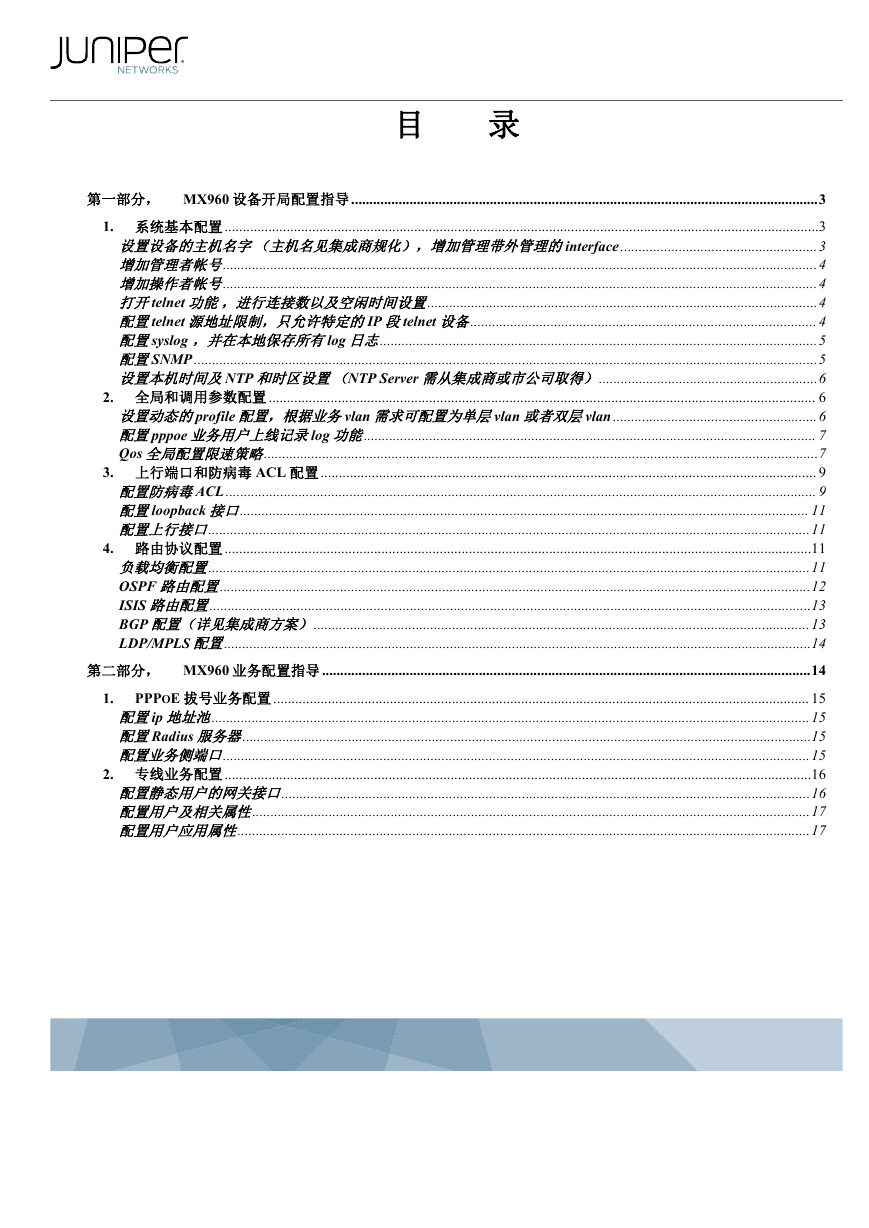
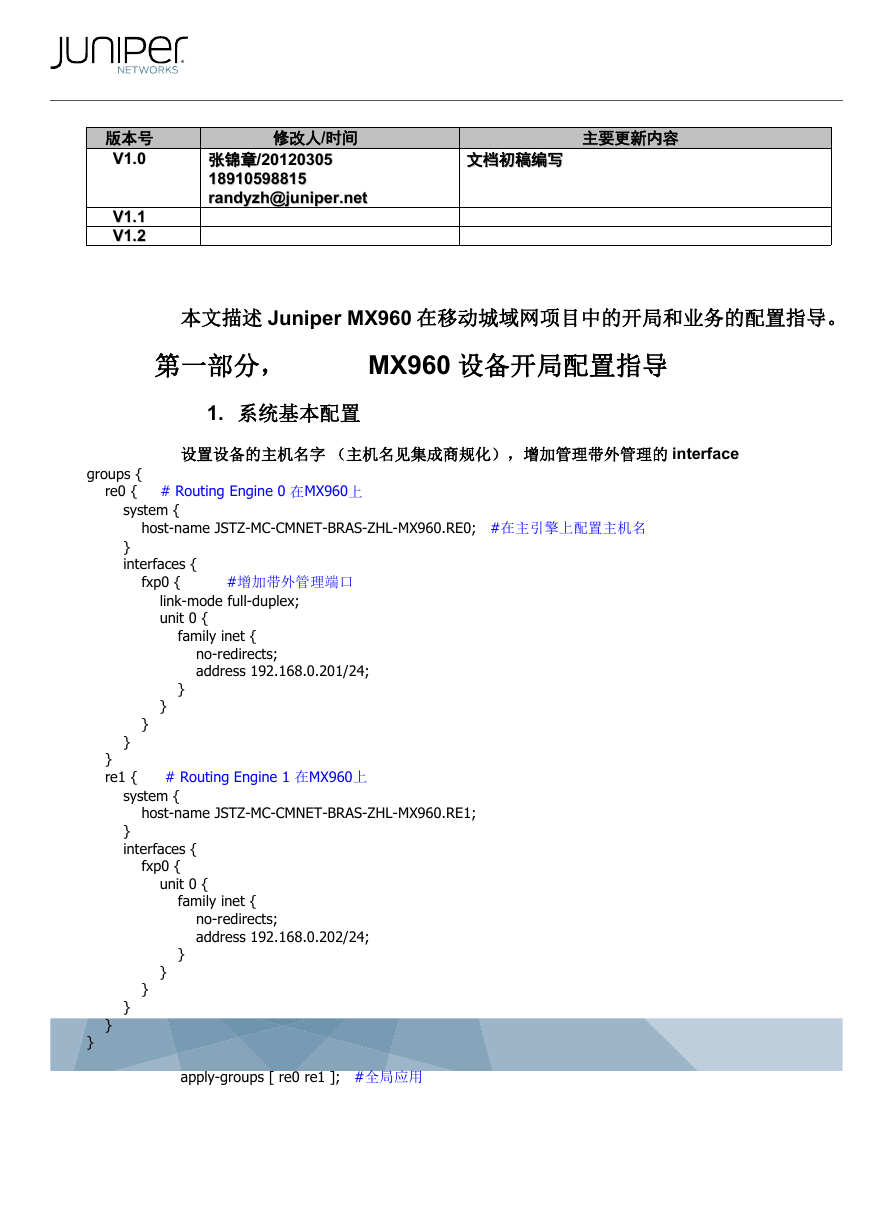
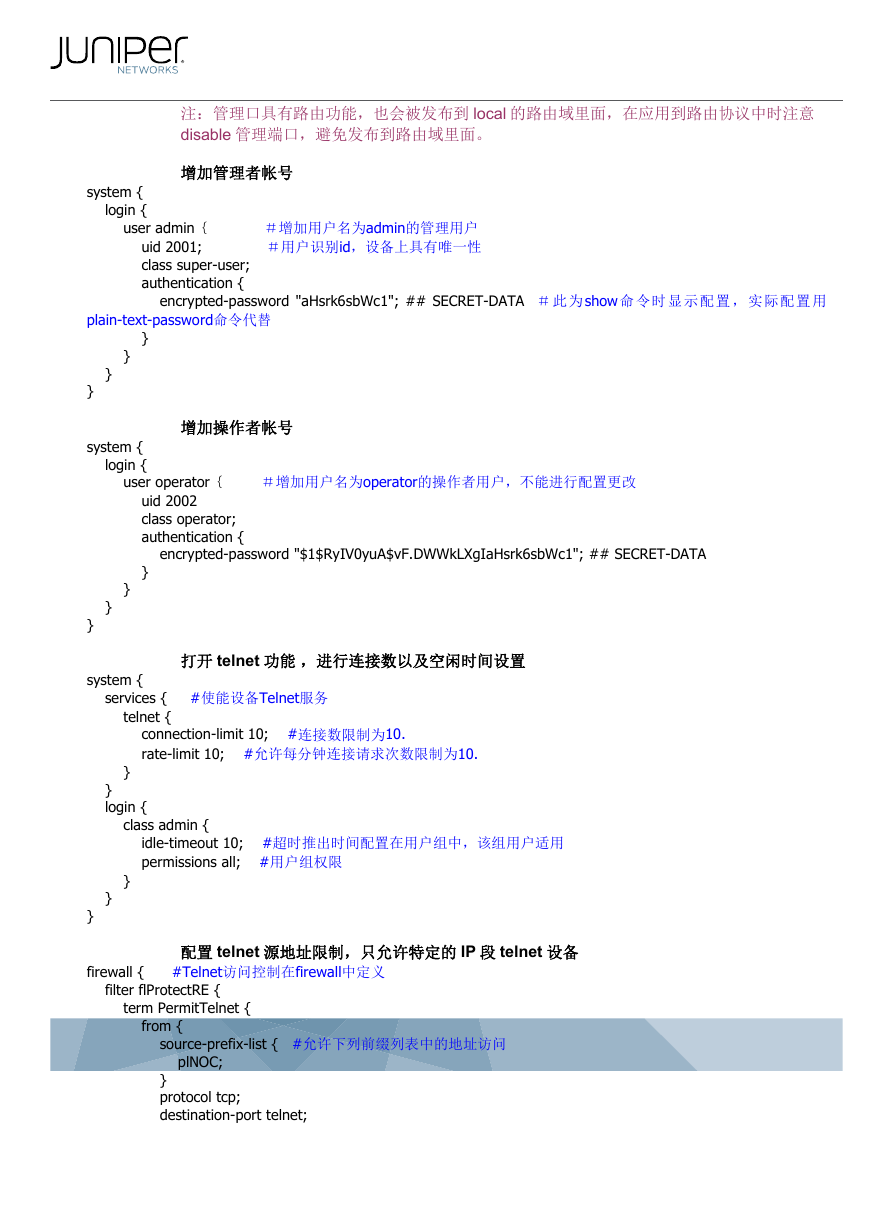
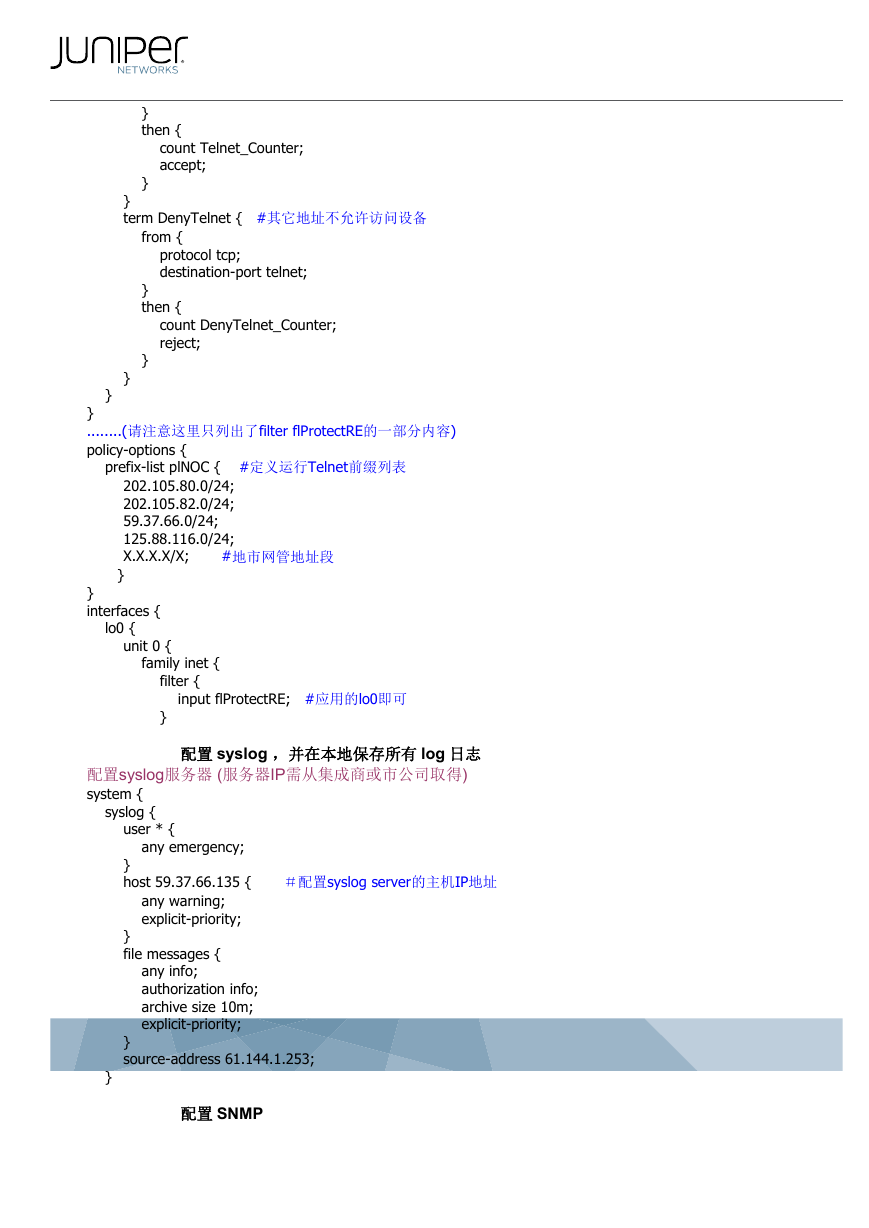
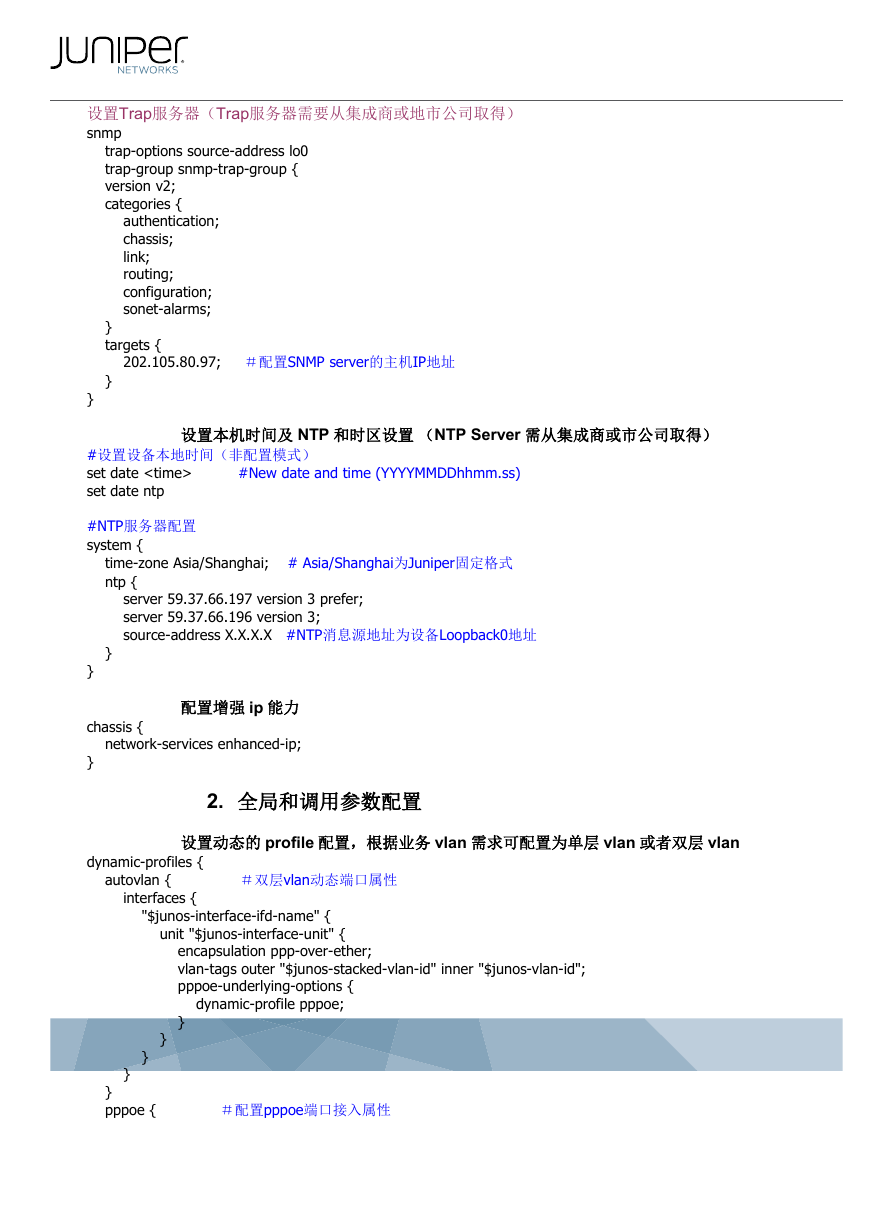
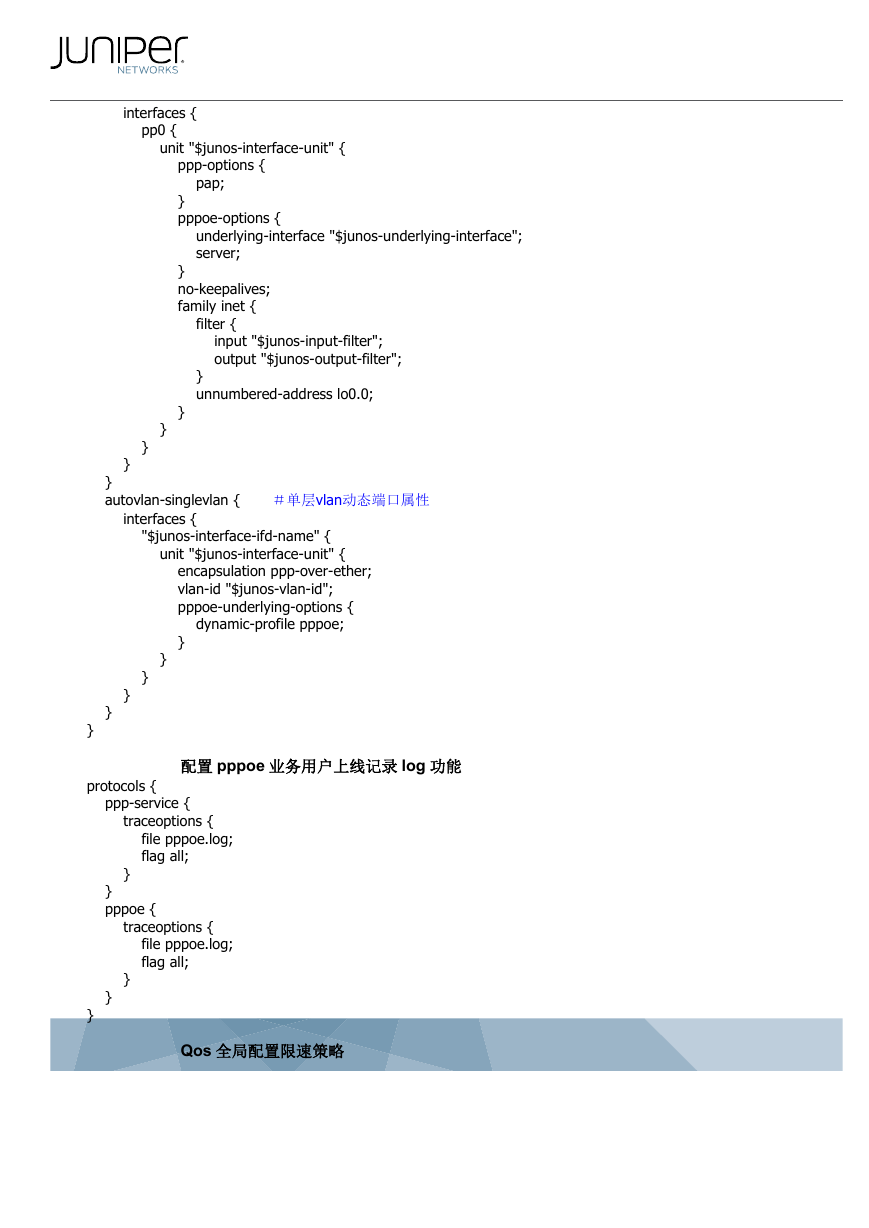









 2023年江西萍乡中考道德与法治真题及答案.doc
2023年江西萍乡中考道德与法治真题及答案.doc 2012年重庆南川中考生物真题及答案.doc
2012年重庆南川中考生物真题及答案.doc 2013年江西师范大学地理学综合及文艺理论基础考研真题.doc
2013年江西师范大学地理学综合及文艺理论基础考研真题.doc 2020年四川甘孜小升初语文真题及答案I卷.doc
2020年四川甘孜小升初语文真题及答案I卷.doc 2020年注册岩土工程师专业基础考试真题及答案.doc
2020年注册岩土工程师专业基础考试真题及答案.doc 2023-2024学年福建省厦门市九年级上学期数学月考试题及答案.doc
2023-2024学年福建省厦门市九年级上学期数学月考试题及答案.doc 2021-2022学年辽宁省沈阳市大东区九年级上学期语文期末试题及答案.doc
2021-2022学年辽宁省沈阳市大东区九年级上学期语文期末试题及答案.doc 2022-2023学年北京东城区初三第一学期物理期末试卷及答案.doc
2022-2023学年北京东城区初三第一学期物理期末试卷及答案.doc 2018上半年江西教师资格初中地理学科知识与教学能力真题及答案.doc
2018上半年江西教师资格初中地理学科知识与教学能力真题及答案.doc 2012年河北国家公务员申论考试真题及答案-省级.doc
2012年河北国家公务员申论考试真题及答案-省级.doc 2020-2021学年江苏省扬州市江都区邵樊片九年级上学期数学第一次质量检测试题及答案.doc
2020-2021学年江苏省扬州市江都区邵樊片九年级上学期数学第一次质量检测试题及答案.doc 2022下半年黑龙江教师资格证中学综合素质真题及答案.doc
2022下半年黑龙江教师资格证中学综合素质真题及答案.doc